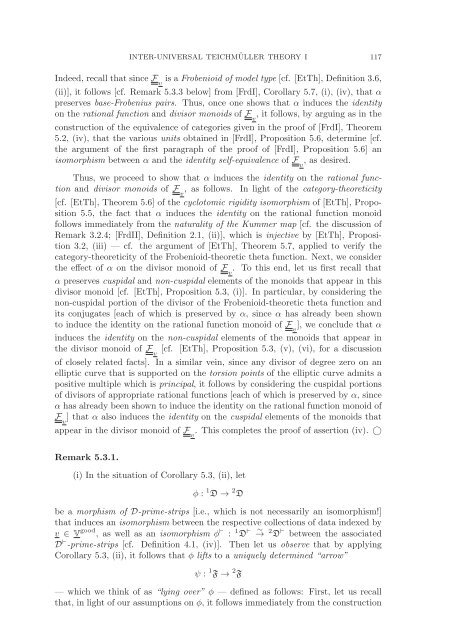Inter-universal Teichmuller Theory I: Construction of Hodge Theaters
Inter-universal Teichmuller Theory I: Construction of Hodge Theaters
Inter-universal Teichmuller Theory I: Construction of Hodge Theaters
Create successful ePaper yourself
Turn your PDF publications into a flip-book with our unique Google optimized e-Paper software.
INTER-UNIVERSAL TEICHMÜLLER THEORY I 117<br />
Indeed, recall that since F v<br />
is a Frobenioid <strong>of</strong> model type [cf. [EtTh], Definition 3.6,<br />
(ii)], it follows [cf. Remark 5.3.3 below] from [FrdI], Corollary 5.7, (i), (iv), that α<br />
preserves base-Frobenius pairs. Thus, once one shows that α induces the identity<br />
on the rational function and divisor monoids <strong>of</strong> F v<br />
, it follows, by arguing as in the<br />
construction <strong>of</strong> the equivalence <strong>of</strong> categories given in the pro<strong>of</strong> <strong>of</strong> [FrdI], Theorem<br />
5.2, (iv), that the various units obtained in [FrdI], Proposition 5.6, determine [cf.<br />
the argument <strong>of</strong> the first paragraph <strong>of</strong> the pro<strong>of</strong> <strong>of</strong> [FrdI], Proposition 5.6] an<br />
isomorphism between α and the identity self-equivalence <strong>of</strong> F v<br />
, as desired.<br />
Thus, we proceed to show that α induces the identity on the rational function<br />
and divisor monoids <strong>of</strong> F v<br />
, as follows. In light <strong>of</strong> the category-theoreticity<br />
[cf. [EtTh], Theorem 5.6] <strong>of</strong> the cyclotomic rigidity isomorphism <strong>of</strong> [EtTh], Proposition<br />
5.5, the fact that α induces the identity on the rational function monoid<br />
follows immediately from the naturality <strong>of</strong> the Kummer map [cf. the discussion <strong>of</strong><br />
Remark 3.2.4; [FrdII], Definition 2.1, (ii)], which is injective by [EtTh], Proposition<br />
3.2, (iii) — cf. the argument <strong>of</strong> [EtTh], Theorem 5.7, applied to verify the<br />
category-theoreticity <strong>of</strong> the Frobenioid-theoretic theta function. Next, we consider<br />
the effect <strong>of</strong> α on the divisor monoid <strong>of</strong> F v<br />
. To this end, let us first recall that<br />
α preserves cuspidal and non-cuspidal elements <strong>of</strong> the monoids that appear in this<br />
divisor monoid [cf. [EtTh], Proposition 5.3, (i)]. In particular, by considering the<br />
non-cuspidal portion <strong>of</strong> the divisor <strong>of</strong> the Frobenioid-theoretic theta function and<br />
its conjugates [each <strong>of</strong> which is preserved by α, sinceα has already been shown<br />
to induce the identity on the rational function monoid <strong>of</strong> F v<br />
], we conclude that α<br />
induces the identity on the non-cuspidal elements <strong>of</strong> the monoids that appear in<br />
the divisor monoid <strong>of</strong> F v<br />
[cf. [EtTh], Proposition 5.3, (v), (vi), for a discussion<br />
<strong>of</strong> closely related facts]. In a similar vein, since any divisor <strong>of</strong> degree zero on an<br />
elliptic curve that is supported on the torsion points <strong>of</strong> the elliptic curve admits a<br />
positive multiple which is principal, it follows by considering the cuspidal portions<br />
<strong>of</strong> divisors <strong>of</strong> appropriate rational functions [each <strong>of</strong> which is preserved by α, since<br />
α has already been shown to induce the identity on the rational function monoid <strong>of</strong><br />
F v<br />
]thatα also induces the identity on the cuspidal elements <strong>of</strong> the monoids that<br />
appear in the divisor monoid <strong>of</strong> F v<br />
. This completes the pro<strong>of</strong> <strong>of</strong> assertion (iv). ○<br />
Remark 5.3.1.<br />
(i) In the situation <strong>of</strong> Corollary 5.3, (ii), let<br />
φ : 1 D → 2 D<br />
be a morphism <strong>of</strong> D-prime-strips [i.e., which is not necessarily an isomorphism!]<br />
that induces an isomorphism between the respective collections <strong>of</strong> data indexed by<br />
v ∈ V good ,aswellasanisomorphism φ ⊢ : 1 D ⊢ → ∼ 2 D ⊢ between the associated<br />
D ⊢ -prime-strips [cf. Definition 4.1, (iv)]. Then let us observe that by applying<br />
Corollary 5.3, (ii), it follows that φ lifts to a uniquely determined “arrow”<br />
ψ : 1 F → 2 F<br />
—whichwethink<strong>of</strong>as“lying over” φ — defined as follows: First, let us recall<br />
that, in light <strong>of</strong> our assumptions on φ, it follows immediately from the construction
















